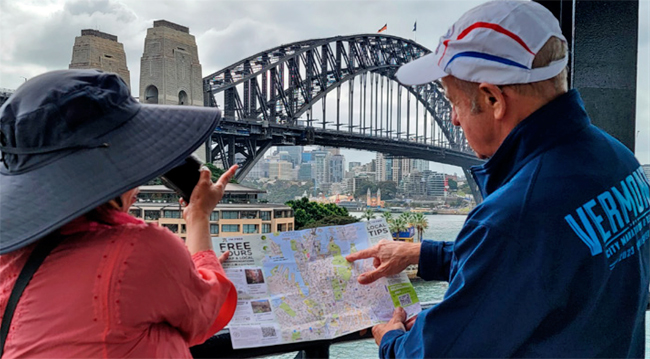Satellite navigation has revolutionized the way we Travelers’ Century Club members navigate our journeys. As GPS systems have become more ubiquitous, one might assume the humble paper map has become obsolete. In fact, according to the Wall Street Journal, the paper map is seeing a bit of a resurgence in recent years. The United Kingdom recently reported a 7% rise in sales of paper maps, and the United States reported an increase of 15% in maps and atlases.
Recently, my wife Henna and I returned from a very successful TCC conference in Calgary, Canada. As an aside, let me give a special shout-out to members Dianne and Steve Owad-Jones and Lana and Tim Skeet for an excellent conference, and the hundreds of hours that they expended in its planning and execution.
While we were in Calgary we had no trouble navigating between the airport, our hotel and the various conference activities using our GPS technology. But while we were there, I had no large-scale geographic reference to where our activities fit into the city as a whole. If, on the other hand, I would have taken a few minutes for a cursory look at a physical city map before I arrived in Calgary, I think I would have had a clearer picture of where we were at any given time.
So let’s take this opportunity to explore some of the reasons behind this growing fondness for paper maps among us travelers, and why these handheld tools are reclaiming relevance in our digital world.
First, there is reliability and independence. Unlike GPS, paper maps don’t depend on battery life or a WiFi connection. They are always available, even as a backup when our satellite-based tool fails or becomes unreliable. This gives us a sense of security and self-sufficiency when exploring new places.
In addition, these maps give us a sense of adventure and discovery. Referring to a paper map gives us a deeper understanding and connection with the land, as one can see geographic features, roads and trails laid out in detail. The act of unfolding a paper map and tracing your fingers across its lines stimulates curiosity and promotes a sense of exploration that digital maps cannot duplicate.
Another advantage is that an actual paper map allows us to visualize an area on a broader scale. This was my problem in Calgary, where I was moving from one place to the next, without seeing the city as a whole. Spreading out a physical map of the city beforehand could have given me an overall picture of where things were. Digital maps usually dictate the shortest, quickest routes, but a paper map enables us to take a more individualized approach. It allows more spontaneity, flexibility and encourages the exploration of lesser-known routes and the discovery of hidden gems along the way.

The paper map can act as a souvenir of your trip. It can evoke memories, allowing us travelers to relive our adventures upon discovering the route we took from Zagreb to Split. The scribbles, markings and notes made on the map become part of our story. The keepsake can provide a tangible and sentimental reminder of the memories we made on the journey.
Finally, paper maps encourage us to interact more with the local environment. By putting away our cell phones and engaging with a tangible map, we are more likely to observe the landscape, ask for directions from locals, and engage with fellow travelers. This increased engagement fosters meaningful connections, cultural exchanges and valuable insights into the places we are exploring.
While these digital navigation systems have undoubtedly revolutionized the way we travel, paper maps have retained their value, and are experiencing a renaissance. The reliability and independence of paper maps, the sense of adventure and discovery they elicit, the spatial awareness and route planning they provide, the memories they preserve and the enhanced engagement they give, are all factors contributing to their increasing popularity with travelers.
So the next time you are leaving on a trip, consider bringing along a paper map and let it guide you on another adventure.



